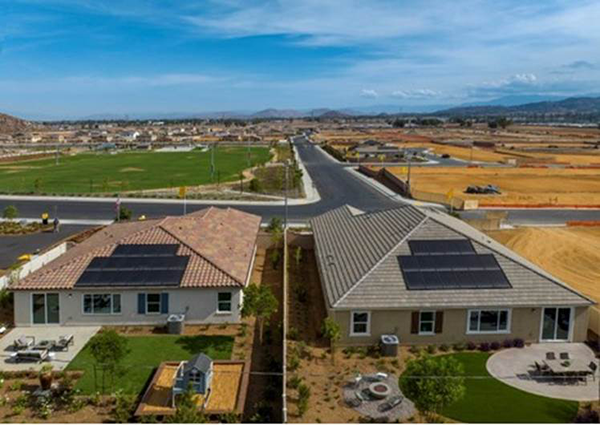Nov. 2, 2022 - The
Advanced Power and Energy Program (APEP) at UCI today announced that it is working with the Department of Energy (DOE),
SunPower®,
KB Home, Southern California Edison® (SCE), and Schneider Electric™ (SE) to develop, deploy and test two
microgrid communities located in the Shadow Mountain master plan in Menifee, California.
A microgrid is a self-supporting energy system that serves a specific geographic footprint, with one or more sources of energy that power the community along with the utility grid. For this research and demonstration project, the all-electric homes are located in two adjacent communities and equipped with solar panels, home batteries, a smart water heater, a smart heating and air conditioning system, and controls that can isolate and energize the homes in the event of a grid outage. Every home will be certified to DOE-designated Zero Energy Ready Home (ZERH) standards which includes ENERGY STAR®, WaterSense® and Indoor airPLUS.
The two communities of 192 homes will have separate microgrids that can be connected when shared resources are determined to benefit both communities.
In addition to the home batteries, a community battery will be shared among the homes. The overall goal of the project is to enhance residential home energy reliability, resiliency and efficiency as well as leverage flexible loads based on an electric microgrid architecture of connected communities.
"This is at the cutting edge of the next generation of home developments," said
Scott Samuelsen, professor emeritus of mechanical, aerospace, and environmental engineering and the co-principal investigator with SunPower. "For homeowners, the digital and connected future and home 'fueling' of electric vehicles demands the enhanced home energy security provided by microgrid technology.
APEP was integral to the design of the project and serves as a facilitator in the engagement of SCE. In the conduct of the project, APEP is collaborating with SCE, SE and SunPower to develop, deploy, and evaluate a microgrid controller designed to interface with the homes, the microgrid energy resources, and the utility grid to achieve the enhanced reliability, resiliency, and energy efficiency expected by the next generation of homeowners. Throughout the project, APEP will simulate the connected microgrids in collaboration with SCE, acquire and archive the data emanating from the project, and conduct research to enhance the technologies deployed in support of future microgrid applications.
APEP will also explore, test and demonstrate the future of "vehicle-to-home" wherein the energy stored in the electric vehicle is available to extend the energy readiness of the home in the event of a grid outage.
Overall, APEP will assure that the microgrid controller meets the national standards (IEEE 2030.7) that evolved from prior research conducted by APEP for the DOE using the UCI Microgrid as a platform for both the development and demonstration. The UCI Microgrid is a 20MW-class microgrid that serves a community of more than 50,000, a wide array of building types (residential, office, research, classroom), transportation options (automobiles, buses, shared-cars, bicycles), and an array of distributed energy resources. Through prior and current research programs, APEP has teamed with the UCI Administration and Facilities Management (FM) to integrate key microgrid hardware, software, and simulation assets into the UCI Microgrid. In partnership with UCI FM and SCE, APEP successfully seamlessly islanded and reconnected the UCI Microgrid from the utility grid. During the 75-minute islanding demonstration, the event was transparent to the campus community even though load demand on the local generation resources changed appreciably.
For more information, visit
www.apep.uci.edu
- William Gary / APEP
